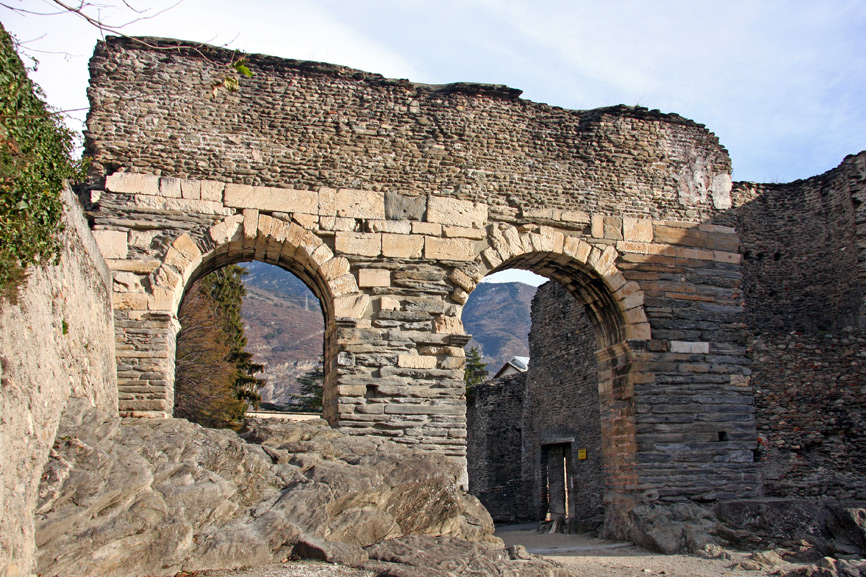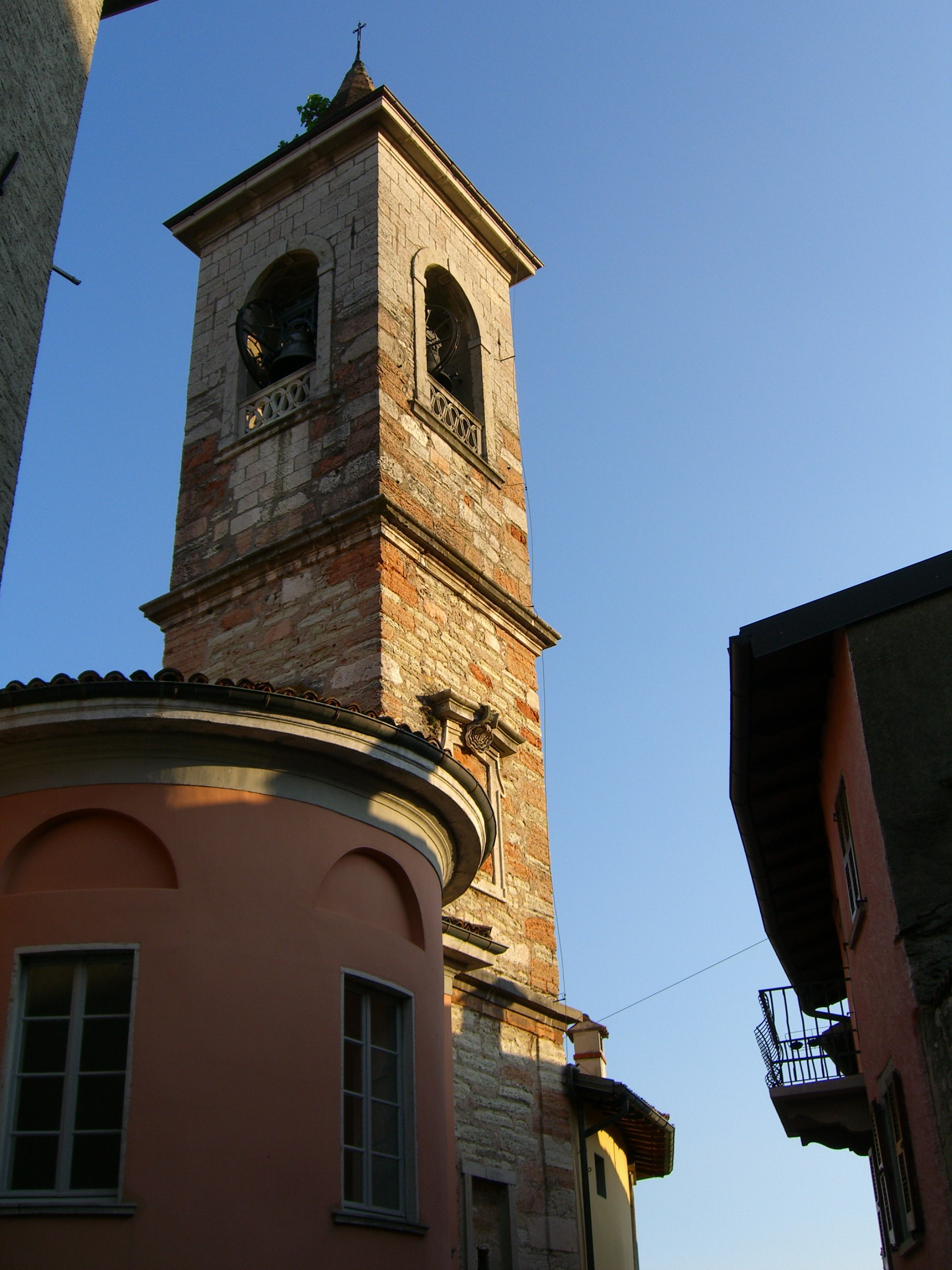|
Monte San Giorgio
Monte San Giorgio is a mountain and UNESCO World Heritage Site on the border between Switzerland and Italy. It is part of the Lugano Prealps, overlooking Lake Lugano in the Swiss Canton of Ticino. Monte San Giorgio is a wooded mountain, rising to 1,097 m (3,600 feet) above sea level. It has a roughly pyramidal shape, with a steep north edge sloping towards Lake Lugano and a more shallow South Slope extending towards the Po Plain. The eastern (Swiss) side of the mountain, between the municipalities of Brusino Arsizio, Riva San Vitale, and Meride, was listed as a World Heritage Site in 2003. This was in recognition of its cultural, biological, and especially paleontological significance. The site is renowned for its fossil content, one of the best known records of marine life in the Middle Triassic period. The Italian region west of Poncione d'Arzo (Porto Ceresio) was added as an extension to the World Heritage Site in 2010. History and cultural heritage Humans have inhabit ... [...More Info...] [...Related Items...] OR: [Wikipedia] [Google] [Baidu] |
Cottian Alps
The Cottian Alps (; french: Alpes Cottiennes ; it, Alpi Cozie ) are a mountain range in the southwestern part of the Alps. They form the border between France (Hautes-Alpes and Savoie) and Italy (Piedmont). The Fréjus Road Tunnel and Fréjus Rail Tunnel between Modane and Susa are important transportation arteries between France (Lyon, Grenoble) and Italy (Turin). Etymology The name ''Cottian'' comes from '' Marcus Julius Cottius'', a king of the tribes inhabiting that mountainous region in the 1st century BC. Under his father Donnus, these tribes had previously opposed but later made peace with Julius Caesar. Cottius was succeeded by his son Gaius Julius Donnus II (reigned 3 BC-4 AD), and his grandson Marcus Julius Cottius II (reigned 5-63 AD), who was granted the title of king by the emperor Claudius. On his death, Nero annexed his kingdom as the province of Alpes Cottiae. History For a long part of the Middle Ages the Cottian Alps were divided between the Duchy of Savo ... [...More Info...] [...Related Items...] OR: [Wikipedia] [Google] [Baidu] |
Indiana University Press
Indiana University Press, also known as IU Press, is an academic publisher founded in 1950 at Indiana University that specializes in the humanities and social sciences. Its headquarters are located in Bloomington, Indiana. IU Press publishes 140 new books annually, in addition to 39 academic journals, and maintains a current catalog comprising some 2,000 titles. Indiana University Press primarily publishes in the following areas: African, African American, Asian, cultural, Jewish, Holocaust, Middle Eastern studies, Russian and Eastern European, and women's and gender studies; anthropology, film studies, folklore, history, bioethics, music, paleontology, philanthropy, philosophy, and religion. IU Press undertakes extensive regional publishing under its Quarry Books imprint. History IU Press began in 1950 as part of Indiana University's post-war growth under President Herman B Wells. Bernard Perry, son of Harvard philosophy professor Ralph Barton Perry, served as the fir ... [...More Info...] [...Related Items...] OR: [Wikipedia] [Google] [Baidu] |
Bituminous
Asphalt, also known as bitumen (, ), is a sticky, black, highly viscous liquid or semi-solid form of petroleum. It may be found in natural deposits or may be a refined product, and is classed as a pitch. Before the 20th century, the term asphaltum was also used. Full text at Internet Archive (archive.org) The word is derived from the Ancient Greek ἄσφαλτος ''ásphaltos''. The largest natural deposit of asphalt in the world, estimated to contain 10 million tons, is the Pitch Lake located in La Brea in southwest Trinidad (Antilles island located on the northeastern coast of Venezuela), within the Siparia Regional Corporation. The primary use (70%) of asphalt is in road construction, where it is used as the glue or binder mixed with aggregate particles to create asphalt concrete. Its other main uses are for bituminous waterproofing products, including production of roofing felt and for sealing flat roofs. In material sciences and engineering, the terms "asphalt ... [...More Info...] [...Related Items...] OR: [Wikipedia] [Google] [Baidu] |
Milan
Milan ( , , Lombard: ; it, Milano ) is a city in northern Italy, capital of Lombardy, and the second-most populous city proper in Italy after Rome. The city proper has a population of about 1.4 million, while its metropolitan city has 3.26 million inhabitants. Its continuously built-up urban area (whose outer suburbs extend well beyond the boundaries of the administrative metropolitan city and even stretch into the nearby country of Switzerland) is the fourth largest in the EU with 5.27 million inhabitants. According to national sources, the population within the wider Milan metropolitan area (also known as Greater Milan), is estimated between 8.2 million and 12.5 million making it by far the largest metropolitan area in Italy and one of the largest in the EU.* * * * Milan is considered a leading alpha global city, with strengths in the fields of art, chemicals, commerce, design, education, entertainment, fashion, finance, healthcar ... [...More Info...] [...Related Items...] OR: [Wikipedia] [Google] [Baidu] |
Arzo
Arzo was a municipality in the district of Mendrisio in the canton of Ticino in Switzerland. It had an area of and a population of 1,126 inhabitants (December 2007). On 5 April 2009 the municipalities of Arzo, Capolago, Genestrerio, Mendrisio, Rancate and Tremona merged into the municipality of Mendrisio Mendrisio (; lmo, label= Ticinese, Mendris ) is a municipality in the district of Mendrisio in the canton of Ticino in Switzerland. Mendrisio is the seat of the Accademia di Architettura of the university of Italian-speaking Switzerland (U .... References External links * * Former municipalities of Ticino Villages in the Mendrisio District {{Ticino-geo-stub ... [...More Info...] [...Related Items...] OR: [Wikipedia] [Google] [Baidu] |
Saltrio
Saltrio is a ''comune'' (municipality) in the Province of Varese in the Italian region Lombardy, located about northwest of Milan and about northeast of Varese, on the border with Switzerland. As of 31 December 2004, it had a population of 2,925 and an area of .All demographics and other statistics: Italian statistical institute Istat. Saltrio borders the following municipalities: Arzo (Switzerland), Clivio, Meride (Switzerland), Viggiù Viggiù (; lmo, Vigiǘu, label= Varesino ) is a ''comune'' (municipality) in the Province of Varese in the Italian region Lombardy, located about northwest of Milan and about northeast of Varese, on the border with Switzerland. Viggiù border .... Demographic evolution Colors= id:lightgrey value:gray(0.9) id:darkgrey value:gray(0.8) id:sfondo value:rgb(1,1,1) id:barra value:rgb(0.6,0.7,0.8) ImageSize = width:455 height:303 PlotArea = left:50 bottom:50 top:30 right:30 DateFormat = x.y Period = from:0 till:4000 TimeA ... [...More Info...] [...Related Items...] OR: [Wikipedia] [Google] [Baidu] |
Viggiù
Viggiù (; lmo, Vigiǘu, label= Varesino ) is a ''comune'' (municipality) in the Province of Varese in the Italian region Lombardy, located about northwest of Milan and about northeast of Varese, on the border with Switzerland. Viggiù borders the following municipalities: Arcisate, Besano, Bisuschio, Cantello, Clivio, Meride (Switzerland), Saltrio. Main sights The church of Santo Stefano, in Romanesque style, was erected at the limit of a crown of houses, which constituted a large and high amphitheater facing the Valceresio area. The church was enlarged in the 15th century to reach its current size, three wide aisles, divided into four bays, separated by six columns and surmounted by capitals. People *Gianni Danzi (1940–2007), Roman Catholic Archbishop of the Territorial Prelature of Loreto *Sandy Cane Sandra "Sandy" Maria Cane (born July 28, 1961, in Springfield, Massachusetts) is an Italian politician who was the former mayor of Viggiù '' comune''. Cane's fat ... [...More Info...] [...Related Items...] OR: [Wikipedia] [Google] [Baidu] |
Limestone
Limestone ( calcium carbonate ) is a type of carbonate sedimentary rock which is the main source of the material lime. It is composed mostly of the minerals calcite and aragonite, which are different crystal forms of . Limestone forms when these minerals precipitate out of water containing dissolved calcium. This can take place through both biological and nonbiological processes, though biological processes, such as the accumulation of corals and shells in the sea, have likely been more important for the last 540 million years. Limestone often contains fossils which provide scientists with information on ancient environments and on the evolution of life. About 20% to 25% of sedimentary rock is carbonate rock, and most of this is limestone. The remaining carbonate rock is mostly dolomite, a closely related rock, which contains a high percentage of the mineral dolomite, . ''Magnesian limestone'' is an obsolete and poorly-defined term used variously for dolomite, for limes ... [...More Info...] [...Related Items...] OR: [Wikipedia] [Google] [Baidu] |
Middle Ages
In the history of Europe, the Middle Ages or medieval period lasted approximately from the late 5th to the late 15th centuries, similar to the post-classical period of global history. It began with the fall of the Western Roman Empire and transitioned into the Renaissance and the Age of Discovery. The Middle Ages is the middle period of the three traditional divisions of Western history: classical antiquity, the medieval period, and the modern period. The medieval period is itself subdivided into the Early, High, and Late Middle Ages. Population decline, counterurbanisation, the collapse of centralized authority, invasions, and mass migrations of tribes, which had begun in late antiquity, continued into the Early Middle Ages. The large-scale movements of the Migration Period, including various Germanic peoples, formed new kingdoms in what remained of the Western Roman Empire. In the 7th century, North Africa and the Middle East—most recently part of the Ea ... [...More Info...] [...Related Items...] OR: [Wikipedia] [Google] [Baidu] |
Roman Empire
The Roman Empire ( la, Imperium Romanum ; grc-gre, Βασιλεία τῶν Ῥωμαίων, Basileía tôn Rhōmaíōn) was the post- Republican period of ancient Rome. As a polity, it included large territorial holdings around the Mediterranean Sea in Europe, North Africa, and Western Asia, and was ruled by emperors. From the accession of Caesar Augustus as the first Roman emperor to the military anarchy of the 3rd century, it was a Principate with Italia as the metropole of its provinces and the city of Rome as its sole capital. The Empire was later ruled by multiple emperors who shared control over the Western Roman Empire and the Eastern Roman Empire. The city of Rome remained the nominal capital of both parts until AD 476 when the imperial insignia were sent to Constantinople following the capture of the Western capital of Ravenna by the Germanic barbarians. The adoption of Christianity as the state church of the Roman Empire in AD 380 and the fall of the Western ... [...More Info...] [...Related Items...] OR: [Wikipedia] [Google] [Baidu] |
14th Century
As a means of recording the passage of time, the 14th century was a century lasting from 1 January 1301 ( MCCCI), to 31 December 1400 ( MCD). It is estimated that the century witnessed the death of more than 45 million lives from political and natural disasters in both Europe and the Mongol Empire. West Africa experienced economic growth and prosperity. In Europe, the Black Death claimed 25 million lives wiping out one third of the European population while the Kingdom of England and the Kingdom of France fought in the protracted Hundred Years' War after the death of Charles IV, King of France led to a claim to the French throne by Edward III, King of England. This period is considered the height of chivalry and marks the beginning of strong separate identities for both England and France as well as the foundation of the Italian Renaissance and Ottoman Empire. In Asia, Tamerlane (Timur), established the Timurid Empire, history's third largest empire to have been ever establ ... [...More Info...] [...Related Items...] OR: [Wikipedia] [Google] [Baidu] |







